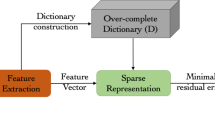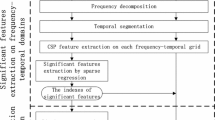Abstract
Motor imagery (MI) based brain-computer interface systems (BCIs) are highly in need for a large number of real-time applications such as hands and touch-free text entry system, movement of a wheelchair, movement of a cursor, prosthetic arm movement, virtual reality systems, etc. In recent years, sparse representation-based classification (SRC) is a growing technique and has been a successful technique on classifying MI-based Electroencephalography (EEG) signals. To further boost the proficiency of SRC technique, in this paper, a weighted SRC (WSRC) has been proposed for classifying MI signals. In WSRC approach, a weighted dictionary has been constructed according to the dissimilarity information between a test data and training samples. Then for the given test data, the sparse coefficients are computed over the weighted dictionary using l0-minimization problem. The sparse solution obtained using WSRC gives discriminative information and as a consequence, WSRC proves to be superior for MI-based EEG classification. The experimental results substantiate that WSRC is more efficient and accurate than SRC.








Similar content being viewed by others
References
Ameri R, Pouyan A, Abolghasemi V (2016) Projective dictionary pair learning for EEG signal classification in brain computer interface applications. Neurocomputing 218:382–389
An X, Kuang D, Guo X, Zhao Y, He L (2014) A deep learning method for classification of EEG data based on motor imagery. In: International conference on intelligent computing. Springer, pp 203–210
Arvaneh M, Guan C, Ang KK, Quek C (2011) Optimizing the channel selection and classification accuracy in EEG-based BCI. IEEE Trans Biomed Eng 58 (6):1865–1873
Baali H, Khorshidtalab A, Mesbah M, Salami MJ (2015) A transform-based feature extraction approach for motor imagery tasks classification. IEEE J Transl Eng Health Med 3:1–8
Bekhti Y, Lucka F, Salmon J, Gramfort A (2018) A hierarchical Bayesian perspective on majorization-minimization for non-convex sparse regression: application to m/eeg source imaging. Inverse Problems
Bell CJ, Shenoy P, Chalodhorn R, Rao RP (2008) Control of a humanoid robot by a noninvasive brain-computer interface in humans. J Neural Eng 5(2):214
Blankertz B, Muller KR, Krusienski DJ, Schalk G, Wolpaw JR, Schlogl A, Pfurtscheller G, Millan JR, Schroder M, Birbaumer N (2006) The BCI competition III: validating alternative approaches to actual BCI problems. IEEE Trans Neural Syst Rehabil Eng 14(2):153–159
Blankertz B, Tomioka R, Lemm S, Kawanabe M, Muller KR (2008) Optimizing spatial filters for robust EEG single-trial analysis. IEEE Signal Process Mag 25(1):41–56
Cai TT, Wang L (2011) Orthogonal matching pursuit for sparse signal recovery with noise. IEEE Trans Inf Theory 57(7):4680–4688
Dokmanic I, Parhizkar R, Ranieri J, Vetterli M (2015) Euclidean distance matrices: essential theory, algorithms, and applications. IEEE Signal Process Mag 32 (6):12–30
Fan Z, Ni M, Zhu Q, Liu E (2015) Weighted sparse representation for face recognition. Neurocomputing 151:304–309
Fang L, Li S, Cunefare D, Farsiu S (2017) Segmentation based sparse reconstruction of optical coherence tomography images. IEEE Trans Med Imaging 36 (2):407–421
Fang L, Wang C, Li S, Benediktsson JA (2017) Hyperspectral image classification via multiple-feature-based adaptive sparse representation. IEEE Trans Instrum Meas 66(7):1646–1657
Gan L, Xia J, Du P, Xu Z (2017) Dissimilarity-weighted sparse representation for hyperspectral image classification. IEEE Geosci Remote Sens Lett 14(11):1968–1972
Grosse-Wentrup M, Buss M (2008) Multiclass common spatial patterns and information theoretic feature extraction. IEEE Trans Biomed Eng 55(8):1991–2000
He B, Baxter B, Edelman BJ, Cline CC, Wenjing WY (2015) Noninvasive brain-computer interfaces based on sensorimotor rhythms. Proc IEEE 103(6):907–925
He L, Hu D, Wan M, Wen Y, von Deneen KM, Zhou M (2016) Common bayesian network for classification of EEG-based multiclass motor imagery bci. IEEE Tran Syst Man Cybern: Syst 46(6):843–854
Huang D, Qian K, Fei DY, Jia W, Chen X, Bai O (2012) Electroencephalography (EEG)-based brain–computer interface (BCI): a 2-d virtual wheelchair control based on event-related desynchronization/synchronization and state control. IEEE Trans Neural Syst Rehabil Eng 20(3):379–388
Jiao Y, Zhang Y, Chen X, Yin E, Jin J, Wang YX, Cichocki A (2018) Sparse group representation model for motor imagery EEG classification. IEEE Journal of Biomedical and Health Informatics
Kevric J, Subasi A (2017) Comparison of signal decomposition methods in classification of EEG signals for motor-imagery BCI system. Biomed Signal Process Control 31:398–406
Kumar S, Sharma A, Mamun K, Tsunoda T (2016) A deep learning approach for motor imagery EEG signal classification. In: 3rd Asia-Pacific World congress on computer science and engineering (APWC on CSE). IEEE, pp 34–39
Kumar S, Sharma A, Tsunoda T (2017) An improved discriminative filter bank selection approach for motor imagery EEG signal classification using mutual information. BMC bioinformatics 18(16):545
Li J, Cichocki A (2014) Deep learning of multifractal attributes from motor imagery induced EEG. In: International conference on neural information processing. Springer, pp 503–510
Li Y, Wen PP (2014) Modified CC-LR algorithm with three diverse feature sets for motor imagery tasks classification in EEG based brain–computer interface. Comput Methods Programs Biomed 113(3):767–780
Li J, Struzik Z, Zhang L, Cichocki A (2015) Feature learning from incomplete EEG with denoising autoencoder. Neurocomputing 165:23–31
Lu N, Yin T (2015) Motor imagery classification via combinatory decomposition of ERP and ERSP using sparse nonnegative matrix factorization. J Neurosci Methods 249:41–49
Lu CY, Min H, Gui J, Zhu L, Lei YK (2013) Face recognition via weighted sparse representation. J Vis Commun Image Represent 24(2):111–116
Lu N, Li T, Ren X, Miao H (2017) A deep learning scheme for motor imagery classification based on restricted Boltzmann machines. IEEE Trans Neural Syst Rehabil Eng 25(6):566–576
McFarland DJ, Wolpaw JR (2008) Brain-computer interface operation of robotic and prosthetic devices. Computer 41:10
McFarland DJ, Krusienski DJ, Sarnacki WA, Wolpaw JR (2008) Emulation of computer mouse control with a noninvasive brain-computer interface. J Neural Eng 5(2):101
Nejati M, Samavi S, Shirani S (2015) Multi-focus image fusion using dictionary-based sparse representation. Inform Fus 25:72–84
Ojeda A, Kreutz-Delgado K, Mullen T (2018) Fast and robust block-sparse Bayesian learning for eeg source imaging. Neuroimage 174:449–462
Ouzir N, Basarab A, Liebgott H, Harbaoui B, Tourneret JY (2018) Motion estimation in echocardiography using sparse representation and dictionary learning. IEEE Trans Image Process 27(1):64–77
Paredes R, Vidal E (2006) Learning weighted metrics to minimize nearest-neighbor classification error. IEEE Trans Pattern Anal Mach Intell 28(7):1100–1110
Park SA, Hwang HJ, Lim JH, Choi JH, Jung HK, Im CH (2013) Evaluation of feature extraction methods for EEG-based brain–computer interfaces in terms of robustness to slight changes in electrode locations. Med Biol Eng Comput 51 (5):571–579
Qiu Z, Jin J, Lam HK, Zhang Y, Wang X, Cichocki A (2016) Improved SFFS method for channel selection in motor imagery based BCI. Neurocomputing 207:519–527
Roy DE (2017) Computer vision: principles, algorithms, applications, learning. Academic Press
Royer AS, Doud AJ, Rose ML, He B (2010) EEG control of a virtual helicopter in 3-dimensional space using intelligent control strategies. IEEE Trans Neural Syst Rehabil Eng 18(6):581–589
Schirrmeister RT, Springenberg JT, Fiederer LDJ, Glasstetter M, Eggensperger K, Tangermann M, Hutter F, Burgard W, Ball T (2017) Deep learning with convolutional neural networks for EEG decoding and visualization. Hum Brain Mapp 38(11):5391–5420
Sharma P, Abrol V, Sao AK (2017) Deep-sparse-representation-based features for speech recognition. IEEE/ACM Trans Audio Speech Lang Process 25(11):2162–2175
Shin Y, Lee S, Lee J, Lee HN (2012) Sparse representation-based classification scheme for motor imagery-based brain–computer interface systems. J Neural Eng 9 (5):056002
Shin Y, Lee S, Ahn M, Cho H, Jun SC, Lee HN (2015) Simple adaptive sparse representation based classification schemes for EEG based brain–computer interface applications. Comput Biol Med 66:29–38
Sreeja SR, Samanta D (2019) Classification of multiclass motor imagery EEG signal using sparsity approach. Neurocomputing 368:133–145
Sreeja SR, Rabha J, Nagarjuna K, Samanta D, Mitra P, Sarma M (2017) Motor imagery EEG signal processing and classification using machine learning approach. In: 2017 International conference on new trends in computing sciences (ICTCS). IEEE, oo 61–66
Sreeja SR, Rabha J, Samanta D, Mitra P, Sarma M (2017) Classification of motor imagery based EEG signals using sparsity approach. In: International conference on intelligent human computer interaction. Springer, pp 47–59
Sreeja SR, Sahay RR, Samanta D, Mitra P (2018) Removal of eye blink artifacts from EEG signals using sparsity. IEEE J Biomed Health Inform 22 (5):1362–1372
Sturm I, Lapuschkin S, Samek W, Müller KR (2016) Interpretable deep neural networks for single-trial EEG classification. J Neurosci Methods 274:141–145
Tabar YR, Halici U (2016) A novel deep learning approach for classification of eeg motor imagery signals. J Neural Eng 14(1):016003
Tang Z, Li C, Sun S (2017) Single-trial EEG classification of motor imagery using deep convolutional neural networks. Optik-Int J Light Electron Opt 130:11–18
Wan M, Li M, Yang G, Gai S, Jin Z (2014) Feature extraction using two-dimensional maximum embedding difference. Inform Sci 274:55–69
Wan M, Yang G, Gai S, Yang Z (2017) Two-dimensional discriminant locality preserving projections (2ddlpp) and its application to feature extraction via fuzzy set. Multimed Tools Appl 76(1):355–371
Wang J, Yang J, Yu K, Lv F, Huang T, Gong Y (2010) Locality-constrained linear coding for image classification. In: IEEE Conference on Computer Vision and Pattern Recognition (CVPR), pp 3360– 3367
Wolpaw J, Wolpaw EW (2012) Brain-computer interfaces: principles and practice. Oxford University Press, USA
Yan C, Xie H, Chen J, Zha Z, Hao X, Zhang Y, Dai Q (2018) A fast uyghur text detector for complex background images. IEEE Trans Multimed 20 (12):3389–3398
Yan C, Li L, Zhang C, Liu B, Zhang Y, Dai Q (2019) Cross-modality bridging and knowledge transferring for image understanding. IEEE Transactions on Multimedia
Zhang S, Zhan Y, Dewan M, Huang J, Metaxas DN, Zhou XS (2012) Towards robust and effective shape modeling: sparse shape composition. Med Image Anal 16(1):265–277
Zhang B, Perina A, Murino V, Del Bue A (2015) Sparse representation classification with manifold constraints transfer. In: Proceedings of the IEEE conference on computer vision and pattern recognition, pp 4557–4565
Zhang Z, Xu Y, Yang J, Li X, Zhang D (2015) A survey of sparse representation: algorithms and applications. IEEE Access 3:490–530
Zhang Y, Zhou G, Jin J, Wang X, Cichocki A (2015) Optimizing spatial patterns with sparse filter bands for motor-imagery based brain–computer interface. J Neurosci Methods 255:85–91
Zhang Y, Zhou G, Jin J, Zhao Q, Wang X, Cichocki A (2016) Sparse Bayesian classification of eeg for brain–computer interface. IEEE Trans Neural Netw Learn Syst 27(11):2256–2267
Zhang Y, Zhou G, Jin J, Zhang Y, Wang X, Cichocki A (2017) Sparse Bayesian multiway canonical correlation analysis for eeg pattern recognition. Neurocomputing 225:103–110
Zhang Y, Nam CS, Zhou G, Jin J, Wang X, Cichocki A (2018) Temporally constrained sparse group spatial patterns for motor imagery BCI. IEEE Trans Cybern 49(9):3322–3332
Zheng Q, Zhu F, Qin J, Heng PA (2018) Multiclass support matrix machine for single trial EEG classification. Neurocomputing 275:869–880
Author information
Authors and Affiliations
Corresponding author
Additional information
Publisher’s note
Springer Nature remains neutral with regard to jurisdictional claims in published maps and institutional affiliations.
Rights and permissions
About this article
Cite this article
Sreeja, S.R., Himanshu & Samanta, D. Distance-based weighted sparse representation to classify motor imagery EEG signals for BCI applications. Multimed Tools Appl 79, 13775–13793 (2020). https://doi.org/10.1007/s11042-019-08602-0
Received:
Revised:
Accepted:
Published:
Issue Date:
DOI: https://doi.org/10.1007/s11042-019-08602-0




